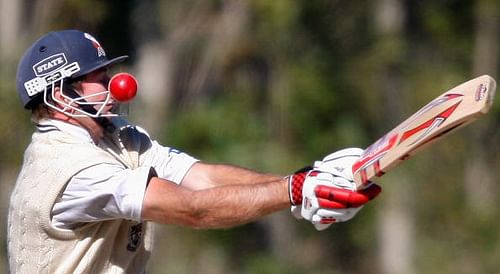
Moments that changed cricket forever: Wearing the ultimate protective gear - helmet

Cricket helmet – saving lives on the pitch
In the current age, it is hard to imagine any of the three forms of cricket being played without a helmet.
With almost everyone (at least in Full Member countries) playing the game as professionals and the proliferation of Twenty20 leagues around the world, it is almost impossible to even think that anyone would have the bravado to go out to bat without a sturdy cover for his head.
So much so that even in Under-19 cricket it is compulsory to wear helmets – not only for batsmen, but also for close-in fielders who are within 15 yards from the batsman’s willow.
The modern-day helmet may still not be an archaic invention, but protective headgear had been around for quite a long while before that.
In its formative years, cricket was played on uncovered pitches often left at the mercy of rain, which would result in low and slow bounce. A batsman therefore had to anticipate deliveries which could scoot below his knee-roll onto his stumps more than the ones which would rise up to his chin.
But all that changed with the “Bodyline” Ashes of 1932-33. Although the bouncer was legal, it was a gentleman’s agreement between bowler and batsman to limit its usage to the bare minimum.
But Douglas Jardine is not called the Erwin Rommel of cricket for nothing. Taking the saying “All is fair in love and war” a bit too literally, Jardine instructed his bowlers to consistently bowl sharp leg-side bouncers to Bradman in a bid to restrain his free flowing stroke play.
While the tactic worked as Bradman scored at an un-Bradman-esque average of 56.57, it opened up a larger can of worms as the MCC rushed to change the rules of the game to prevent further exploitation of the loopholes that existed.
But the new rules were not to come into effect until 1935 and soon after the aforementioned series, the West Indians were supposed to tour England. As always, they had a more than potent line-up of fast bowlers consisting of the likes of Manny Martindale and Baron Constantine and were expected to be the best bet for paying England back in their own coin.
Of all the English players, no one was more concerned more about this than Patsy Hendren. Hendren had taken the West Indian attack to the cleaners in their own backyard three years ago, and he knew they would be thirsting for revenge.
He knew they would target his weakness for compulsive hooking and so when he came out to bat at Lord’s, it was in a rubber hat with three peaks, two of which fit in snugly over the sides of his head.
It was his own invention, and although it did not start a fashion fad, over the years batsmen started using hats to face up to fast bowling.
This tactic might not have been the most practical – there have been instances of hats falling onto the stumps and making a mighty mess out of them – but it seemed to have worked psychologically as the likes of Sunil Gavaskar stood up to the bouncer barrage of the mighty West Indian attack of the 70s in their floppy hats.
It was not until the Packer Revolution that the batting fraternity realised something was amiss. Ever the rebel with or without a cause, Dennis Amiss was one of the first to jump onto the World Series Cricket bandwagon and even went on the first “rebel” tour to South Africa in 1982.
But probably the greatest contribution of his desire to experiment and try something new was the first prototype of the modern day helmet. And, like any major invention, it had humble origins.
Back then, West Indies had their “Fearsome Foursome” and Australia had the Jeff Thomson and Dennis Lillee combination along with the likes of Len Pascoe and Rodney Hogg. World Series Cricket was more of a gladiatorial combat than the sedate game of cricket played in the English countryside, and Amiss realised that a broken skull would do his chances of earning some good money no good.
So he went to a motorcycle helmet manufacturer who came up with a lighter version of the fibreglass biking helmets of the days. The polycarbonate helmet had a fibreglass visor which could withstand a shotgun blast at 10 yards which meant that Amiss, or at least his head, would be relatively safe against the likes of Marshall and company.
28 years later, the helmet sold for 400 pounds at the BBC’s 20th Century Roadshow – a trifling amount for a significant piece of cricket history.
Amiss and his England teammate Mike Brearley, who used his own design, would go on to popularise the helmet in Test cricket, although neither of them was the first person to do so.